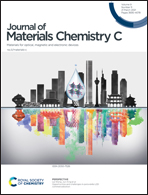Highly efficient room-temperature organic afterglow achieved by collaboration of luminescent dimeric TADF dopants and rigid matrices†
Abstract
Here we report a highly efficient room-temperature afterglow system based on difluoroboron β-diketonate (BF2bdk) dopants and tetralone matrices. The BF2bdk compounds have been synthesized by an efficient cascade reaction from aromatic substrates and exhibit high photoluminescence quantum yield in both solution and solid state. Upon doping, BF2bdk-tetralone materials at room temperature have been shown to display greenish yellow afterglow emission that can last for 4 s and to possess an afterglow quantum yield up to 26% under ambient conditions, which is among the highest yields of the reported dopant–matrix organic afterglow systems. After being ground into aqueous suspension with the aid of an aqueous solution of amphiphilic block copolymers, the BF2bdk-tetralone materials have been found to retain their afterglow properties, show capability in avoiding the interference of a strong fluorescence background, and exhibit both ex vivo and in vivo high-contrast bioimaging functionalities.



 Please wait while we load your content...
Please wait while we load your content...